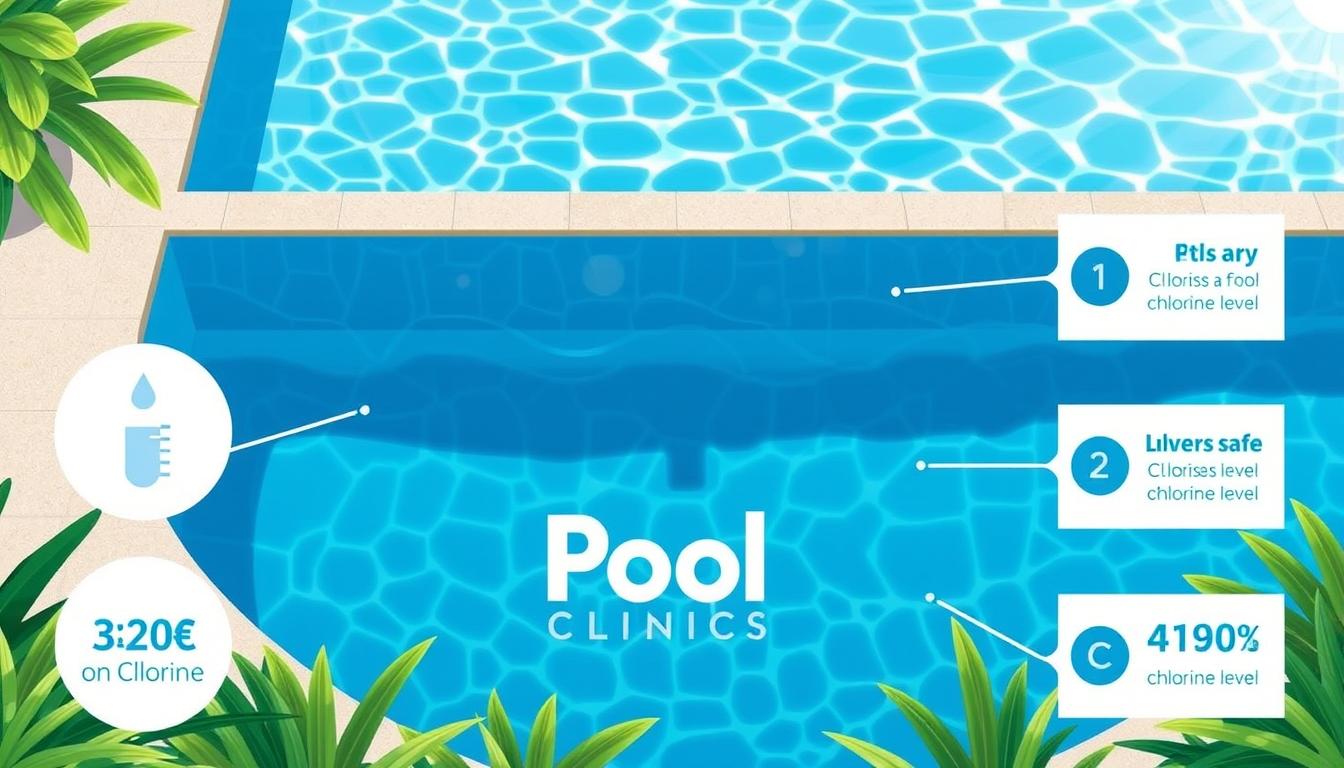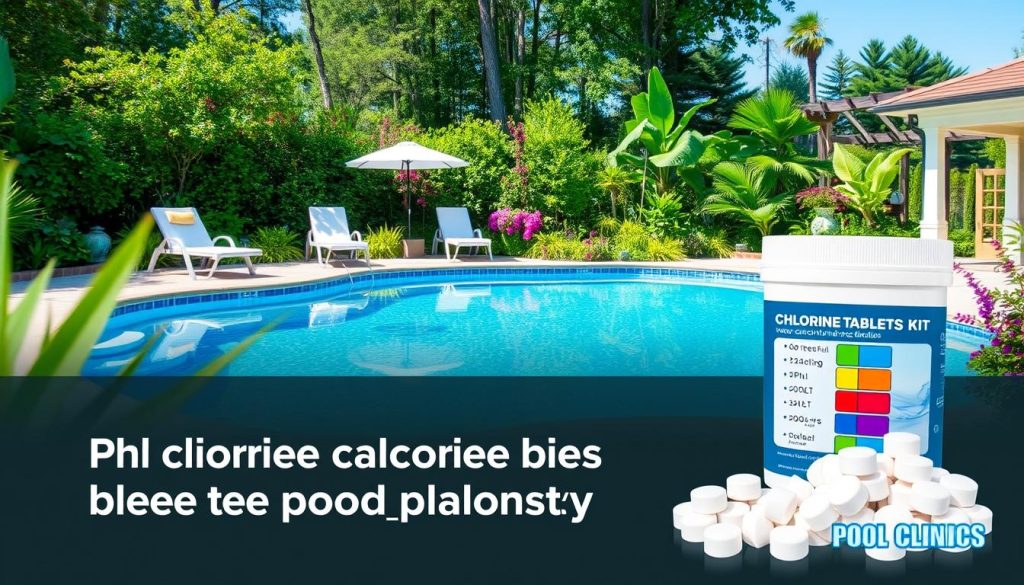
Pool owners want clean, safe pools for refreshing swims. Proper chlorine levels keep water free from harmful bacteria and algae. But how soon can you swim after adding chlorine tablets?
This guide explores factors influencing pool maintenance. You’ll learn when it’s safe to dive in after chlorinating your pool.
Chlorine tablets are popular for their convenience and effectiveness. They slowly dissolve, releasing chlorine into the water. This keeps your pool sanitized and clean.
Adding chlorine tablets requires patience before swimming safely. It’s crucial to understand the process and timing.
Key Takeaways
- The general guideline for adding chlorine tablets is two 3-inch tablets per 10,000 gallons of water.
- The recommended chlorine level for safe swimming is between 1 to 3 parts per million (ppm).
- Regular water testing and chlorine adjustments are essential for maintaining optimal pool chemistry.
- Factors such as sunlight, water temperature, and bather load can affect chlorine dispersal and efficiency.
- Always follow the manufacturer’s instructions and wait the recommended time before swimming after adding chlorine tablets.
Understanding Chlorine Tablets and Pool Chemistry
Chlorine tablets are key to safe swimming. They work with balanced pool chemistry to keep water clean. Understanding how they work helps maintain a healthy pool environment.
How Chlorine Tablets Work to Sanitize Your Pool
Chlorine tablets slowly release hypochlorous acid into pool water. This acid kills bacteria, viruses, and other harmful microorganisms. The tablets provide steady chlorine levels, keeping the water safe.
Ideal free chlorine levels should be 1-4 ppm. This ensures proper sanitization without irritating swimmers’ eyes and skin.

Balancing Pool Chemistry for Optimal Chlorine Effectiveness
Chlorine tablets work best in balanced pool chemistry. Several factors contribute to this balance.
- pH Levels: Keep pool water pH between 7.2 and 7.6. This prevents corrosion and clouding issues.
- Alkalinity: Maintain levels between 100 and 150 ppm. This stabilizes pH and ensures chlorine effectiveness.
- Calcium Hardness: For concrete pools, aim for 200-500 ppm. Vinyl pools need 175-225 ppm.
Test your pool water weekly to monitor these levels. Test more often during heavy use or after storms.
Proper pool chemistry prevents damage to surfaces and equipment. It also ensures chlorine works effectively.
| Pool Chemistry Component | Ideal Range |
|---|---|
| Free Chlorine | 1-4 ppm |
| pH | 7.2-7.6 |
| Alkalinity | 100-150 ppm |
| Calcium Hardness (Concrete/Plaster) | 200-500 ppm |
| Calcium Hardness (Vinyl/Fiberglass) | 175-225 ppm |
Good pool chemistry and proper chlorine tablet use keep water clean and safe. Next, we’ll discuss safety guidelines for swimming after adding chlorine tablets.
Safety Guidelines for Swimming After Adding Chlorine Tablets
Pool safety is crucial after adding chlorine tablets. It’s important to follow guidelines for safe swimming. This prevents health risks and ensures chemical effectiveness.
We’ll explore wait times, factors affecting chlorine dispersal, and risks of swimming too soon. These tips will help maintain a safe pool environment.
Recommended Wait Times for Safe Swimming
Allow enough time for chlorine tablets to dissolve and spread evenly. Wait at least 30 minutes to an hour after adding chlorine before swimming.
This waiting period lets chemicals work effectively. It eliminates harmful bacteria, algae, and other contaminants. The wait time may vary depending on the type of chlorine tablets used.
For pool shock treatments, wait until chlorine levels drop to 1-3 ppm. This usually takes about 24 hours. Always test the water before entering the pool.
| Type of Chlorine | Recommended Wait Time |
|---|---|
| Regular Chlorine Tablets | 30 minutes to 1 hour |
| Shock Treatments | 24 hours or until chlorine levels reach 1-3 ppm |
Factors That Affect Chlorine Dispersal and Efficiency
Several factors influence chlorine dispersal and efficiency in your pool. These factors impact the waiting time before swimming.
- Sunlight: UV rays break down chlorine, reducing its effectiveness. Use a chlorine stabilizer to protect against sunlight degradation.
- Water Temperature: Higher temperatures speed up chlorine dissipation. Monitor and adjust chlorine levels more often in warm water.
- Circulation System: A good system distributes chlorine evenly. Run the pump and filter daily to maintain proper levels.
Potential Health Risks of Swimming Too Soon After Chlorination
Swimming too soon after chlorination can cause health problems. High chlorine levels may lead to skin irritation, rashes, and eye discomfort.
Swimmers might experience respiratory issues like coughing and wheezing. Accidentally ingesting pool water may cause nausea and vomiting.
- Skin irritation, redness, and rashes
- Eye discomfort, burning sensation, and redness
- Respiratory issues, such as coughing, wheezing, and difficulty breathing
- Nausea and vomiting if pool water is accidentally ingested
“It’s crucial to prioritize the health and safety of swimmers by adhering to recommended wait times and regularly testing the pool water chemistry. By doing so, we can ensure a pleasant and healthy swimming experience for everyone.”
Follow recommended wait times and test pool water before swimming. Monitor pH levels between 7.4 and 7.6. Keep free chlorine levels within 1-3 ppm.
These steps create a safe and enjoyable swimming environment. Regular maintenance ensures a healthy pool for everyone to enjoy.
How Soon Can You Swim After Adding Chlorine Tablets?
Adding chlorine tablets keeps swimming pools clean and safe. It’s crucial to wait before swimming to let chlorine disperse properly. The tablet’s dissolution time determines when it’s safe to swim.
General Guidelines for Different Types of Chlorine Tablets
Waiting times vary based on the tablet type used. Slow-dissolving trichlor tablets take several hours to fully disperse. These provide gradual, consistent chlorine release over time.
Fast-dissolving calcium hypochlorite tablets may allow swimming after about an hour. Always check the product label for specific waiting times.
Testing Chlorine Levels Before Entering the Pool
Test chlorine levels with a reliable pool water kit before swimming. The safe free chlorine range is 1-3 parts per million (ppm). If levels are too high, wait until they decrease.
Test pool water at least weekly, or more often for busy pools. This ensures chlorine stays at safe levels. Proper chlorine levels prevent algae growth and keep water clear.
The waiting time depends on the tablet type used. Slow-dissolving tablets need longer than fast-dissolving ones. Always check product instructions for guidance. Test water before swimming to ensure chlorine is 1-3 ppm.







